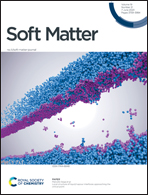Transparent ionic conductive elastomers with high mechanical strength and strong tensile properties for strain sensors†
Abstract
Stretchable ionic conductive elastomers have been extensively studied due to their great application potential in the fields of sensors, batteries, capacitors and flexible robots. However, it is still challenging to prepare multifunctional ionic conductive elastomers with high mechanical strength and excellent tensile properties by a green and efficient method. In this study, we prepared PDES–DMA ionic conductive elastomers by a “one step” rapid in situ polymerization of AA/ChCl-type polymerizable deep eutectic solvents (PDES) and N,N-dimethylacrylamide (DMA) under ultraviolet (UV) irradiation. In addition to the characteristics of high mechanical strength (tensile strength of 9.27 MPa) and excellent tensile properties (elongation at break of 1071%), the PDES–DMA elastomer also has high transparency (>80%), strong self-adhesion (adhesion strength with glass surface 133.8 kPa) and self-healing properties. In addition, sensors based on the ionic conductive elastomer can be used to detect human movements such as finger, wrist, elbow, ankle and knee bending. Considering the convenience of the preparation method and the excellent versatility of the prepared PDES–DMA ionic conductive elastomer, we believe that the method proposed in this study has potential application prospects in the field of flexible electronics.



 Please wait while we load your content...
Please wait while we load your content...